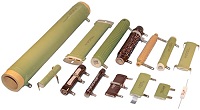Wirewound Resistors
Faqs

A 20W ceramic wirewound resistor of 5 ohmA wire wound resistor is an electrical passive component that limits current. The resistive element exists out of an insulated metallic wire that is winded around a core of non-conductive material. The wire material has a high resistivity, and is usually made of an alloy such as Nickel-chromium (Nichrome) or a copper-nickel-manganese alloy called Manganin. Common core materials include ceramic, plastic and glass. Wire wound resistors are the oldest type of resistors that are still manufactured today. They can be produced very accurate, and have excellent properties for low resistance values and high power ratings.
The construction of this type of resistor is also very simple. In wire wound resistor a wire of manganin or constantan is wound around a cylinder of insulated material. The temperature coefficient of resistance of these two materials is almost zero. So there would no resistance variation with temperature. The wounded wire is covered with an insulating material such as baked enamel. This cover of insulating heat resistible material is provided to resist the effect of ambient temperature variation. Different sizes and ratings of wire wound resistor can easily be achieved by using different lengths and diameters of the wire. These resistors are easily available for wide range of ratings. The range of resistance values varies from 1 O to 1 MO. Typical tolerance limit of these resistors varies from 0.01 % to 1 %. They can be used for high power applications of 5 to 200 W dissipation ratings. The cost of these resistors is much higher than carbon resistor. Normally wire wound resistor is used where carbon composition resistor cannot meet the purpose because of its limitations.
Characteristics and Materials
While wirewound resistor materials and designs vary, all involve a length of resistive wire wrapped around a ceramic, fiberglass, or plastic core. The wire typically consists of copper or silver alloy, but pure metals such as tungsten are used in high-temperature (> ~1300° C) applications.
|
TypesWirewound resistors may be broadly classified into one of the three categories described in the table below.
|
Authorize Line: (*)
- ASJ Components *
- ATE Electronics *
- Caddock Electronics
- Fenghua *
- HTR Resistors *
- IBS Resistors*
- IRC *
- Meritek *
- Micron Resistors*
- RCD*
- RG Allen *
- Royal Ohm Resistors*
- SEI *
- Vishay Foil Resistor*
- Vitrohm*
- Walsin*
- Yageo*
*************************
- Allen Bradley / Rockwell Automation
- ASJ Components
- BI Technologies
- Bourns
- C.T.S.
- Clarostat
- Dale/Vishay
- Hi-Tech Resistor
- IBS Resistors
- IRC
- KOA
- Megitt
- Noble
- Ohmite
- Rockwell
- Phycom
- Piher International Corp
- RG Allen*
- RCD Components
- Rohm
- S.E.I. Electronics
- Sincera
- Siegert
- Electronics
- Spectrol
- TE Connectivity
- Venkel
- Vishay
- Vitrohm
- Walsin
- Welwyn
- Yageo*